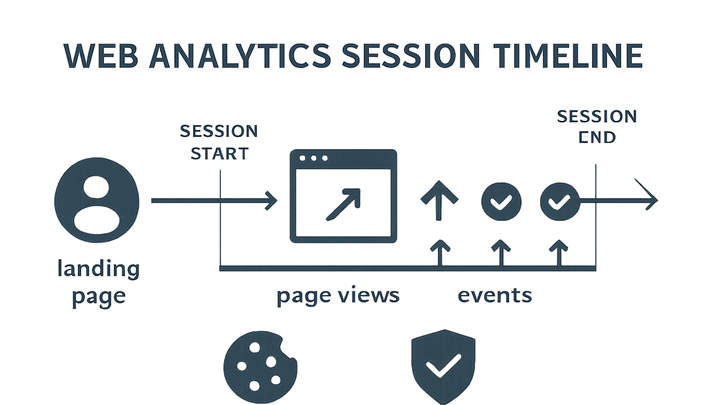Published on 2025-06-28T06:02:48Z
What is Session Data? Examples for Session Data in Web Analytics
Session data in web analytics represents a user’s interactions grouped into a single visit or ‘session.’ It typically begins when a visitor first lands on your site or app and ends after a period of inactivity (commonly 30 minutes) or when the browser is closed. Session data includes page views, events (like clicks or form submissions), transactions, and other engagement metrics tracked during that visit. Understanding session data helps analysts measure engagement, conversion funnels, and user behavior over discrete visits. Different analytics platforms—such as GA4 and PlainSignal—implement session tracking in slightly different ways, balancing accuracy, complexity, and user privacy.
Session data
Session data groups a user’s page views, events, and transactions into a single visit defined by start, duration, and end.
Core Concepts of Session Data
This section defines what a session is in analytics and why it matters for measuring user engagement and behavior.
-
Session definition
A session is a group of user interactions (page views, events, transactions) occurring within a defined time window. It starts when a visitor first triggers a page load or event and ends after inactivity or browser closure.
-
Key components
Each session is identified by a session ID and tracks start time, end time, duration, and the sequence of user actions.
-
Session lifecycle
Sessions begin on arrival, persist across pages or screens, expire after a period of inactivity (default 30 min), and reset on re-entry or extended engagement.
How Session Data Is Collected
Different methods exist to group user actions into sessions. This section covers common techniques and PlainSignal’s cookie-free approach.
-
Cookies and first-party identifiers
Traditional analytics platforms use first-party cookies (e.g., _ga in GA4) or localStorage to persist a session ID across page loads.
-
Session identifiers
A unique session token (often a UUID) is generated on first interaction and sent with each hit to tie events back to the same visit.
-
Cookie-free tracking (PlainSignal)
PlainSignal uses an in-memory session token and browser fingerprinting heuristics to group interactions without storing cookies. It resets on browser close and honors privacy by design.
Comparing GA4 and PlainSignal Session Handling
GA4 and PlainSignal both track sessions but differ in technology, privacy posture, and reporting depth.
-
GA4 session handling
GA4 fires a session_start event on entry, uses a 30-minute default timeout, and persists session ID via the _ga cookie or localStorage. It supports cross-platform sessions with User ID stitching.
-
PlainSignal session handling
PlainSignal generates a session token in memory on each visit, uses a 30-minute inactivity timeout, and avoids cookies entirely. It offers simpler dashboards focusing on privacy-first insights.
-
Reporting and metrics
GA4 provides detailed session metrics, user lifetime analysis, and path exploration. PlainSignal reports sessions, page views, and events in a lightweight interface without complex funnels.
Best Practices for Session Data
Optimize session tracking for accuracy, especially in modern web apps and under privacy constraints.
-
Session timeout configuration
Adjust the inactivity timeout (default 30 min) to match typical user behavior; shorter for fast-moving sites, longer for media-heavy content.
-
Handling single-page applications
Ensure virtual page_view or route_change events are sent on SPA navigation to keep the session active and capture all user actions.
-
Deduplication and merging
Filter out bot traffic and merge duplicate sessions by checking client IDs and user IDs to avoid overstating visit counts.
Privacy and Compliance Considerations
Session tracking must respect user privacy regulations like GDPR and CCPA. This section covers key compliance steps.
-
Gdpr/ccpa requirements
Obtain consent before setting identifiers, offer opt-out mechanisms, and honor Do Not Track signals to respect user privacy.
-
Anonymization and ip masking
Mask or truncate IP addresses and avoid storing PII in session data to reduce compliance risk.
-
Advantages of cookie-free tracking
Eliminates the need for cookie banners in many jurisdictions and reduces the risk of third-party cookie deprecation affecting data collection.
Example Implementation
Code snippets for enabling session tracking in PlainSignal and GA4.
-
PlainSignal tracking snippet
Add this to your site’s <head> to enable cookie-free session tracking with PlainSignal:
<link rel="preconnect" href="//eu.plainsignal.com/" crossorigin /> <script defer data-do="yourwebsitedomain.com" data-id="0GQV1xmtzQQ" data-api="//eu.plainsignal.com" src="//cdn.plainsignal.com/plainsignal-min.js"></script> -
GA4 tracking configuration
Include the gtag snippet and replace GA_MEASUREMENT_ID. GA4 will automatically handle sessions:
<!-- Global site tag (gtag.js) --> <script async src="https://www.googletagmanager.com/gtag/js?id=GA_MEASUREMENT_ID"></script> <script> window.dataLayer = window.dataLayer || []; function gtag(){dataLayer.push(arguments);} gtag('js', new Date()); gtag('config', 'GA_MEASUREMENT_ID', { 'send_page_view': true }); </script>
